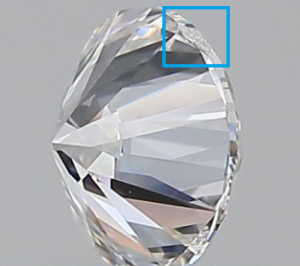Diamonds are timeless symbols of strength, luxury, and enduring love. Over the centuries, their allure has stemmed from their sparkle, hardness, and rarity. Yet, the artistry of these gemstones is often more profound, with individual character given by their unique inclusions. A captivating feature known as ‘Intended Natural’ graces some of these majestic stones, enhancing their desirability and individuality. This essay delves into the intriguing world of ‘Intended Natural’ diamond inclusions.

The Diamond’s Inner World: A Brief Introduction
In essence, a diamond’s internal structure can tell an incredible story about its formation and journey from deep within the Earth. These gemstones form under extreme heat and pressure over billions of years, during which inclusions may form.
Inclusions are minute imperfections or foreign materials trapped within the diamond during its formation. They vary in size, shape, and visibility, influencing the clarity, color, and overall value of the gemstone. Each diamond tells a unique story through these inclusions, acting as a fingerprint that sets each gem apart.
The Nature of ‘Intended Natural’ Inclusions
An ‘Intended Natural’ inclusion is not your ordinary diamond characteristic. This term is primarily used in the diamond industry to denote a part of the original rough diamond’s surface that’s left on the polished stone. It’s usually found on or near the girdle of the diamond, which is the widest part of the stone, separating the top (crown) from the bottom (pavilion).
Leaving a portion of the rough diamond’s surface is not a manufacturing oversight. Instead, it’s a deliberate choice by the diamond cutter. In most cases, this strategic decision allows the cutter to retain the maximum weight from the original rough diamond, hence optimizing its value.
The Impact on Diamond Value
How does the ‘Intended Natural’ feature influence the value of a diamond? Its impact varies depending on its visibility, size, and location. As with any diamond inclusion, it can reduce the clarity grade of a diamond if it’s conspicuous or negatively impacts the stone’s transparency or brilliance.
However, the ‘Intended Natural’ inclusion, given its unique nature, might not always reduce a diamond’s value. Certain buyers appreciate these inclusions for the character they add to a diamond, viewing them as a unique identifier rather than a flaw. It can even enhance the diamond’s appeal, particularly for those who value the charm of untouched, natural elements in their gemstones.
The Ethical Dimension of ‘Intended Natural’ Inclusions
In the world of gemstones, ‘Intended Natural’ diamonds have a unique advantage. As they embody a part of the diamond’s original rough state, they can serve as a visible testament to the diamond’s ethical sourcing.
For consumers increasingly concerned about the environmental and social impacts of diamond mining, ‘Intended Natural’ inclusions offer tangible reassurance. They show that the diamond hasn’t been subjected to potential treatments or enhancements to mask inclusions, indicating a natural, unaltered state.
The Beauty in the Flaws
In the end, the allure of ‘Intended Natural’ inclusions lies in the celebration of nature and authenticity. Just as the Japanese art of Kintsugi glorifies the cracks in pottery by filling them with gold, ‘Intended Natural’ inclusions embrace the imperfections and the story they tell about the diamond’s billion-year journey from the depths of the Earth to a cherished piece of jewelry.
In the intricate world of diamonds, understanding inclusions like the ‘Intended Natural’ brings us closer to appreciating the depth and individuality that each gemstone holds. Far from being mere flaws, these inclusions reveal the true essence of what makes each diamond unique, reminding us that there is beauty in embracing the natural and the authentic.